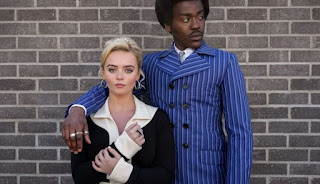I got asked if any of the Vapour Trails episodes I'd done in the past are still available, and to my surprise, I found most are. In fact, I think actually all of them are there apart from a special Stephen D Brooks and I did on Klaus Voormann in 2024, and the Manfred Mann special that we recorded early in 2024, but were unable for technical reasons to put out, so no-one got to hear it.
This is my blog for posting material of academic interest (to me). Expect to see stuff about Greek and Roman history, archaeology, Classical literature, the Ancient Near East, historical films, teaching, the reception of the Classics in science fiction, the abuse of history, science fiction criticism, Doctor Who, and occasionally other historical stuff, or just things that I'm interested in. Expect spoilers at all times.
Saturday, December 28, 2024
Past Vapour Trails
I got asked if any of the Vapour Trails episodes I'd done in the past are still available, and to my surprise, I found most are. In fact, I think actually all of them are there apart from a special Stephen D Brooks and I did on Klaus Voormann in 2024, and the Manfred Mann special that we recorded early in 2024, but were unable for technical reasons to put out, so no-one got to hear it.
Friday, December 27, 2024
Boxing Day Vapour Trails
I did a radio show, talking about some of my favourite tunes. Includes one track I can almost guarantee you've never heard before.
Wednesday, September 11, 2024
An Introduction to Greek and Roman Mythology
I have, as ever, completely forgotten to plug this until the deadline is almost upon us. An online course I'm teaching for pre-college kids.
Tuesday, August 20, 2024
Virtual launch for AI in Greek and Roman Epic
This Wednesday I shall be taking part (remotely) in the official launch of the edited volume AI in Greek and Roman Epic.
Friday, August 16, 2024
Quick updates
Saturday, May 18, 2024
Notes on Doctor Who and History: 'Space Babies', 'The Devil's Chord' and 'Boom'
'Space Babies' is mostly set in the far future, though there are a couple of slips backwards in time. The Doctor (Ncuti Gatwa) takes Ruby Sunday (Millie Gibson) back to a beautifully-realised Wyoming 150 million years in the past. There, we get a brief gag that derives from Ray Bradbury's short story 'A Sound of Thunder'. There is also a flashback to Christmas 2004, the day on which baby Ruby was abandoned at the Church on Ruby Road, the one place the Doctor says he can't take Ruby, and therefore the one place we are guaranteed to visit before the end of the season.
But the historical meat of the first three episodes is, of course, to be found in 'The Devil's Chord'. The episode begins in 1925, with a character whose sharing a name with the third Robin (of Batman and... fame) may or may not be a coincidence. 1925 isn't sketched out in any particular detail, but it doesn't need to be. Then we switch to Ruby, asking to go to February 1963 to see The Beatles recording their first album, something the Doctor considers a much better idea than wanting to go to the Titanic or Bethlehem, presumably at the time of the birth of Jesus. (Incidentally, I don't think television Doctor Who has gone to either event, though there is a photo in 'Rose' of the Doctor with a family he persuaded not to go on the doomed liner, and in 'The End of the World' he says he was on a ship that is presumably the Titanic. No surprise that spin-off materials involve both events.)
Doctor Who has, of course, been to 1963 before, in 'An Unearthly Child', which is referenced here, and 'Remembrance of the Daleks', which is not. On neither occasion did 1963 look quite as it does here. The Beatles have also been on Doctor Who before, not that you'd know this from iPlayer, where the short clip of them playing 'Ticket to Ride' has been excised from 'The Executioners' (episode 1 of 'The Chase'), though fortunately not from the Blu-Ray, so it is still possible to watch William Russell's painful attempt to look 'hip'). 'The Devil's Chord' finds a very neat diegetic way in which to get around the fact that even Disney can't afford to license a Beatles song for this episode.
The Doctor and Ruby change into outfits that are very much Swinging London. But Swinging London didn't really exist until 1965, and the Doctor's suit is more redolent of 1967-1969. In 1963, most men dressed like accountants. Most bands dressed like scruffy accountants. Even The Beatles had yet to don their trademark collarless jackets. The truly hip (the Beat Poets, and the like) dressed all in black.
 |
| A rare photo of John Lennon in the style of glasses he wore up to 1966. |
Now, people can, and have, responded to lists of the anachronisms by saying 'look, it's just a silly fantasy episode, it's not meant to be the real Sixties'. To which I say, yes, that's my point. The episode presents an artificial idea of what 'The Sixties' was like. And what interests me is how and why that's been put together. So, John wears those glasses because those are the John Lennon glasses, the ones that everyone expects. The boys have longer hair because that's what everyone thinks The Beatles looked like. (Crueller writers than me might suggest such tactics are necessary because the actors don't look much like The Beatles, but then neither did Christopher Eccleston or Peter Capaldi.) The female singer could have been the more plausible Helen Shapiro (a friend of The Beatles) or Alma Cogan (a future friend of The Beatles), but that would make the viewers go 'who?' Everyone knows Cilla, and that she was associated with The Beatles. Pronouncing Brian Epstein's name as 'Epsteen' would be authentic - that's how Brian himself pronounced it - but the pronunciation as 'Epstine' is pretty ubiquitous these days (I try to avoid it when I do internet radio about the Beatles). When we see the famous Abbey Road zebra crossing, we expect there to be a white Volkswagen parked on the left, and don't worry that the car must, therefore, have been abandoned for six years.
Fiona Moore observed to me that at least since the 1980s people have forgotten how different the early 1960s were from the late, and indeed how much fashion was limited in its distribution. (For an example of this latter point, watch Get Back or Let It Be and compare how The Beatles dress with how roadie Mal Evans or even director Michael Lindsay-Hogg dresses, let alone all the people on the street listening to the band play on the rooftop at Savile Row.) Television quite often prints the legend rather than the reality; the Doctor and Ruby's outfits are all part of this, perhaps slyly sent up by the fact that they change out of outfits that actually were more suitable to 1963 (Russell T Davies' Doctor Who is nothing if not knowing). This is a phenomenon that can be seen in other television, such as, if perhaps to a lesser extent, in the recent television version of The IPCRESS File, also set in 1963. It's much more obvious in fantasy versions of the sixties such as the Austin Powers movies, and the Doctor's suit looks like a deliberate nod in that direction. This sort of conflation is a thing we tend to do to historical periods; note the way cultural differences between the Victorians of the 1840s and the Victorians of the 1890s can get elided in popular culture, or, to choose my own period, differences between first-century Rome and fifth-century Rome.
This is an episode filled with elements derived from various bits of the 1960s, and especially The Beatles' career. Matthew Kilburn rightly draws attention to the 'Aeolian tones' recalling the 'Aeolian cadences' that music critic William Mann attributed to The Beatles in 1963, and Maestro's outfit in the latter stages has hints of The Beatles' outfits for Sergeant Pepper, and more obviously the hussar jackets that almost everybody seemed to wear in the second half of 1967. Several people have rightly observed that the plot of 'The Devil's Chord' owes quite a bit to The Beatles' 1968 animated movie Yellow Submarine. And the musical number at the end has its roots in endless 1960s pop musicals (though not any The Beatles made, with the possible exception of Magical Mystery Tour) - though again, Austin Powers is perhaps a more immediate influence.
It's a shame the final chord played by John and Paul wasn't the last chord of 'A Day In The Life', but you can't have everything.
The engagement of 'Boom' with the past is largely with the show's own history, in particular 'Genesis of the Daleks'; the main plot is based on the landmine scene from Part One of that serial, with Ruby Sunday in the role of Harry Sullivan. This follows the previous week's call back to 'Pyramids of Mars'. Apart from that, we get the Doctor singing 'The Skye Boat Song', but there's no commentary along the lines of 'I nearly met Bonnie Prince Charlie once'.
Wednesday, May 08, 2024
Octavia
Christopher J Garcia has done an issue of The Drink Tank on Ancient Rome, and I have a short piece in it about Octavia, the sister of Augustus. Lots of other interesting stuff in there as well.
Sunday, April 28, 2024
Upcoming MANCENT and LRAC events
I've got quite a few events coming up. I've just started a MANCENT course on the Trojan War. We're coming up to week 2, but you can still book for the whole course and get the recording of week 1. You can also buy a ticket just for this week's session.
Friday, April 12, 2024
The Trojan War: Myth and history?
I have a new blog post up on the MANCENT blog, about the 'history' behind the Trojan War. This is to do with my upcoming course on The Trojan War, for which you can book tickets here.




.jpg)







